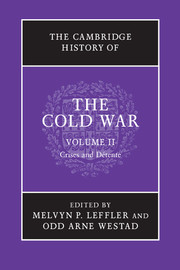Book contents
- Frontmatter
- 1 Grand strategies in the Cold War
- 2 Identity and the Cold War
- 3 Economic aspects of the Cold War, 1962–1975
- 4 The Cuban missile crisis
- 5 Nuclear competition in an era of stalemate, 1963–1975
- 6 US foreign policy from Kennedy to Johnson
- 7 Soviet foreign policy, 1962–1975
- 8 France, “Gaullism,” and the Cold War
- 9 European integration and the Cold War
- 10 Détente in Europe, 1962–1975
- 11 Eastern Europe: Stalinism to Solidarity
- 12 The Cold War and the transformation of the Mediterranean, 1960–1975
- 13 The Cold War in the Third World, 1963–1975
- 14 The Indochina wars and the Cold War, 1945–1975
- 15 The Cold War in the Middle East: Suez crisis to Camp David Accords
- 16 Cuba and the Cold War, 1959–1980
- 17 The Sino-Soviet split
- 18 Détente in the Nixon–Ford years, 1969–1976
- 19 Nuclear proliferation and non-proliferation during the Cold War
- 20 Intelligence in the Cold War
- 21 Reading, viewing, and tuning in to the Cold War
- 22 Counter-cultures: the rebellions against the Cold War order, 1965–1975
- 23 The structure of great power politics, 1963–1975
- 24 The Cold War and the social and economic history of the twentieth century
- Bibliographical essay
- Index
- References
14 - The Indochina wars and the Cold War, 1945–1975
Published online by Cambridge University Press: 28 September 2010
- Frontmatter
- 1 Grand strategies in the Cold War
- 2 Identity and the Cold War
- 3 Economic aspects of the Cold War, 1962–1975
- 4 The Cuban missile crisis
- 5 Nuclear competition in an era of stalemate, 1963–1975
- 6 US foreign policy from Kennedy to Johnson
- 7 Soviet foreign policy, 1962–1975
- 8 France, “Gaullism,” and the Cold War
- 9 European integration and the Cold War
- 10 Détente in Europe, 1962–1975
- 11 Eastern Europe: Stalinism to Solidarity
- 12 The Cold War and the transformation of the Mediterranean, 1960–1975
- 13 The Cold War in the Third World, 1963–1975
- 14 The Indochina wars and the Cold War, 1945–1975
- 15 The Cold War in the Middle East: Suez crisis to Camp David Accords
- 16 Cuba and the Cold War, 1959–1980
- 17 The Sino-Soviet split
- 18 Détente in the Nixon–Ford years, 1969–1976
- 19 Nuclear proliferation and non-proliferation during the Cold War
- 20 Intelligence in the Cold War
- 21 Reading, viewing, and tuning in to the Cold War
- 22 Counter-cultures: the rebellions against the Cold War order, 1965–1975
- 23 The structure of great power politics, 1963–1975
- 24 The Cold War and the social and economic history of the twentieth century
- Bibliographical essay
- Index
- References
Summary
The struggle for Indochina after 1945 occupies a central place in the international history of the twentieth century. Fought over a period of three decades, at the cost of millions of lives and vast physical destruction in Vietnam, Laos, and Cambodia, the conflict captured in microcosm all of the grand political forces that drove the century’s global history: colonialism, nationalism, communism, and democratic-capitalism. It was both an East–West and a North–South struggle, that is to say, intimately bound up with the two most important developments in international relations after World War II, the Cold War and the breakup of the colonial empires.
It took time, however, for Indochina to become a major cockpit of tensions in the international system. In the early years, the conflict was largely a Franco-Vietnamese affair, resulting from Paris leaders ‘attempt to rebuild the colonial state and international order from before World War II, and Vietnamese nationalists’ determination to redefine that state in a new postcolonial order. France had lost colonial control when, after the fall of France in 1940, Japan swept southward and gradually gained effective control of the whole of Southeast Asia. The Tokyo authorities initially found it convenient to leave the day-to-day control of Indochinese affairs in French hands, but in March 1945 the Japanese brushed aside the French in favor of ruling Indochina themselves. By then the tide of the Pacific War had turned against them, however, and in the weeks and months that followed, the French government and various Vietnamese nationalist groups – the most powerful of which was the Communist-led Vietminh under Ho Chi Minh – jockeyed for power.
- Type
- Chapter
- Information
- The Cambridge History of the Cold War , pp. 281 - 304Publisher: Cambridge University PressPrint publication year: 2010
References
- 10
- Cited by

